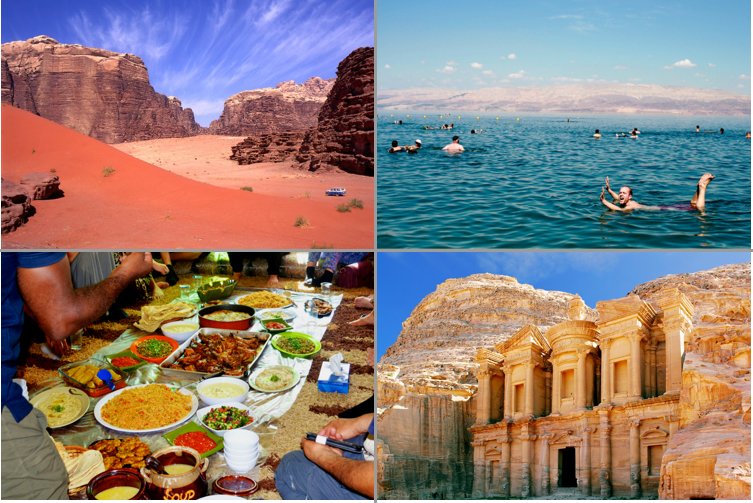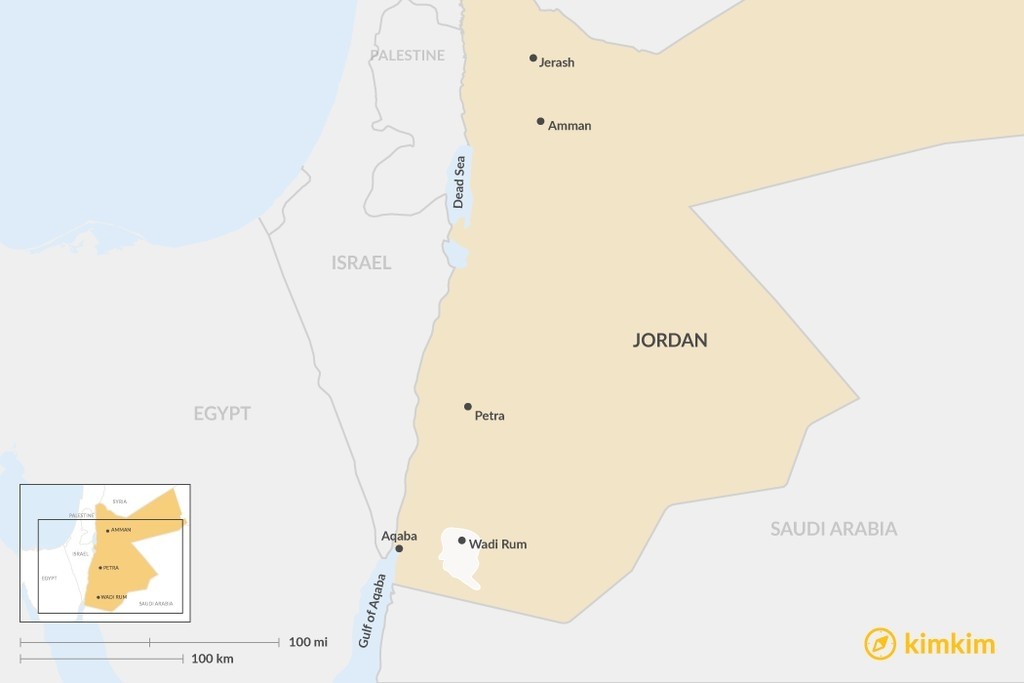Highlights
- Wander the streets of ancient civilizations in Petra and Jerash
- Take a Jordanian cooking class in Amman
- Soak up the sun on the beaches of Aqaba and the Dead Sea
- Spend a night in the desert wilderness of Wadi Rum
Where to Go in Jordan
Jordan may be small, but what it lacks in size is made up for in its sheer volume of cultural landmarks and scenery. Boasting five UNESCO World Heritage Sites, endless archeological treasures, and expanses of unique natural wilderness, Jordan is dynamic enough for even the most ambitious of travelers. No matter where your sightseeing priorities lie, there are a number of places in Jordan you simply shouldn't miss. Here are our top picks and tips for Jordan's must-see places.
#1 Amman
Jordan's capital city is one of the best-kept secrets in the Middle East. A relatively young metropolis by local standards (founded in 5500 BC), you'll find that Amman has a perfect mix of cultural tradition and modern appeal.
The best way to see Amman is on foot, so be sure to opt for a walking tour of the Old City, starting with two of the famous attractions: the Citadel, an ancient hilltop fort, and the equally time-worn Roman Theater. Weave through back streets, colorful food markets, and tiny shops full of handmade crafts. Eat authentic Jordanian cuisine like mansaf - an aromatic meal of roasted lamb and yogurt sauce, widely regarded to be the country's national dish - and be sure to make a stop at the impressive King Abdullah Mosque, with its photo worthy blue mosaic dome. Once you've had your fill of architectural wonders, peruse the contemporary art galleries of Jebal Al-Waibdeh and hang out in the hip pubs and shops on Rainbow Street.
Where To Eat: Treat yourself to traditional Jordanian fare in a beautiful setting at Sufra - make sure to ask for a table outside on the garden patio of this Rainbow Street restaurant. Afterward, make a stop for dessert downtown at Habibah Sweets, where you'll find some of the best knafeh in the city.
Where To Stay: AlQasr Metropole is a mid-size boutique hotel in the stylish Shmeisani neighborhood. It has multiple restaurants, including an Italian trattoria, and a number of spacious rooms with balconies overlooking the city.
Pro Tip: Book a class at Beit Sitti, or "Grandmother's House," a cooking school located in a beautiful house. Come to master traditional Jordanian dishes from bona fide chefs, and stay to enjoy the incredible food you prepared with their help!
#2 Petra
When people dream about visiting Jordan, the lost city of Petra is what they usually envision. One of the Seven Wonders of the Modern World, this remnant of ancient Nabatean civilization is an expanse of intricate rock-cut architecture in Jordan's southwestern desert.
Grab your tickets and a map at the visitor center in nearby Wadi Musa before heading to the park. Take your time entering through the Siq, a narrow gorge with towering walls, eventually coming to the famous facade of the enormous Treasury building. Make a stop at the Amphitheater before continuing to the Colonnaded Street and the Qasr al-Bint temple. You can also climb - on foot or horseback - to the Monastery, admiring the view of the Royal Tombs on the way back down.
Your options in Petra are truly endless; you could spend an entire week taking in the ruins and hiking the trails. One especially rewarding trek takes you to the top of Mount Aaron, a holy site according to multiple religions. It's a challenging climb, but the spectacular views are worth it!
Where To Eat: Cave Bar is a two-millennia-old Nabatean tomb in Wadi Musa, converted into a lively hub for nightlife at the Petra Guest House. Drinks here are a must, but if you're hungry, they also offer pub fare like potato wedges and barbecued meat skewers.
Where to Stay: A charming B&B known for its warm hospitality and huge backyard garden, the Fig Tree Villa is located in a quiet section of Wadi Musa that's just a short walk from Petra's entrance.
Pro Tip: The Petra By Night experience is a must for anyone spending at least 24 hours in the area. You'll have the unique opportunity to see the dramatic walls of the Siq by candlelight before finding a seat in front of the majestic Treasury for tea and Bedouin music under the stars.
#3 Wadi Rum
Wadi Rum is one of the world's most beautiful deserts. A protected wilderness near Jordan's southern border, Wadi Rum is made unique by the dramatic sandstone and basalt mountains jutting out of its sandy floor. Named "The Valley of the Moon," the area's intrigue is endless, from stunning formations to fascinating rock art. Beyond the inherent beauty of Wadi Rum, its storied history and a rich cultural element add to its allure as a destination: inscriptions and scattered ruins can be found throughout the desert. To get the most bang for your buck, take a 4x4 Jeep tour to explore the dramatic canyons and arches, stopping periodically to climb red sand dunes and admire the petroglyphs.
Staying overnight in Wadi Rum is highly recommended. Tour providers typically have associated overnight camps that range from rustic to luxurious, and most offer delicious Bedouin dishes for dinner, accompanied by storytelling and live music performed on traditional instruments. Perhaps the best part is the brilliant night sky - second only to the cup of hot tea you'll enjoy the next morning.
Where To Eat: All of the camps and tours in Wadi Rum offer classic Bedouin fare like zarb, a traditional form of barbecued meat cooked in a pit in the ground, and magloubah, a veggie-heavy dish served with rice. One staple is the sweet, black tea that locals drink throughout the day. By the end of your stay, you might be hooked!
Where to Stay: There are plenty of tourist camps for you to select from, all with fairly similar offerings: tent cabins, a kitchen, and an outdoor lounge area around the fire. Try the luxurious Wadi Rum Night Camp, a "glamping" outpost with domed bubble tents made partially of transparent plastic, perfect for stargazing.
Pro Tip: The sky is the limit when it comes to adventure in Wadi Rum, so be sure to add some extra activities to your agenda. Ride a camel to some well-known sights, go rock climbing with a guide on ancient sandstone walls, or take in the peaceful desert sunrise from a hot air balloon.
#4 Gulf of Aqaba
The Gulf of Aqaba is Jordan's access point to the warm waters of the Red Sea. Its coastline is packed with cushy resorts, seafood restaurants, and excellent public beaches, making this a busy vacation spot for Jordan residents from the north. The warm gulf waters also serve as a mecca for snorkelers and scuba divers who come for the vast array of undersea wildlife at sites like the Yamanieh Coral Reef in the Aqaba Marine Park.
But there's more to Aqaba than sea, sand, and sun - inhabited since 4000 BC, the city also has an array of Islamic-era ruins and artifacts. The Aqaba Archeological Museum is a destination in itself, boasting a large collection of antiquities, and the next-door Aqaba Castle is also worth a look. A significantly more modern example of 20th-century Islamic architecture is the Sharif Hussein Bin Ali Mosque, a gleaming white building in the center of town.
Where To Eat: Given your location, you'll likely want to take advantage of the fresh seafood, and Ali Baba is a great place to do it. A longstanding Aqaba establishment, this restaurant has locally caught fish and a big wrap-around terrace.
Where to Stay: A good mid-range option is Al Qidra, a conveniently located hotel with large, airy rooms and a welcoming staff. Breakfast is included in the cost of your stay - along with a shuttle to the beach for those who want to skip the ten-minute stroll.
Pro Tip: Aqaba hotels and resorts are actually a great lodging option for travelers who want to visit nearby Wadi Rum but are uninterested in camping. Many local hotels are helpful in arranging day-trip transportation and tours - just pay a visit to the concierge desk.
#5 Jerash
One of the oldest Roman cities in the Middle East, Jerash is the jewel of northern Jordan. Surrounded by fertile farmland and rolling hills, the once-powerful ancient city is only thirty miles from Amman, making it convenient for a day trip or quick overnight. Jerash's ruins are exquisitely preserved - you can access a few of them free of charge, but many are within boundaries of a ticketed archeological park (and are certainly worth the $7 admission fee).
Start with Hadrian's Arch, the original southern gate to the city, and the Hippodrome, a Roman stadium that hosts performances of mock gladiator fights and chariot races. Head to the main site and wander through the classic arches and limestone plazas, making sure to spend time among the 56 columns at the Temple of Zeus.
Where To Eat: Get away from the crowds and head to The Olive Branch, a vegetarian-friendly restaurant situated in a hilltop hotel. The property is named for its ubiquitous olive groves, and guests will enjoy meals prepared with freshly pressed olive oil and organic produce from the garden.
Where to Stay: Just across from the main ruins, Hadrian's Gate Hotel is the perfect spot for travelers who want to be in the middle of the action. Looking for something more mellow? Try the Mountain Breeze Resort, a lodging option in the Gilead Mountains with sweeping views and lots of amenities.
Pro Tip: Beyond the city itself, Jerash is also known for its lush surroundings and fertile soil. Embrace the bountiful fresh fruit stands you'll see along every road, and make sure to get your fill of the region's famously delicious plums, figs, and olives.
#6 Dead Sea
Known for its high salinity and mineral rich mud, the Dead Sea is attractive to tourists looking to relax. Located at 400 meters below sea level - the lowest elevation in the world - the density of this big, calm body of water makes floating a breeze. However, there's more to Jordan's Dead Sea region than the sea itself. Activities are plentiful: pay a visit to the Hammamat Ma'in, a group of natural hot springs and waterfalls funneled into man-made pools and baths, or explore the nearby Mujib Nature Preserve.
You might also indulge in a mud wrap or another of the regional spa specialties known for their healing properties. Luxury accommodations abound, and though you can easily make a day trip happen from Amman, you'll want to stick around for at least one night. Lounging at (and in) the Dead Sea is a perfect way to wind down from an adventurous trip through Jordan, so be sure to save it for the end of your journey.
Where To Eat: Options for stand-alone restaurants are extremely limited in the Dead Sea area, and on the public beach, there are only a couple of mediocre outposts. Stick to the resorts for a proper meal; Burj al Hamam at the Crowne Plaza is a great choice.
Where to Stay: The Kempinski Hotel Ishtar has multiple pools, four restaurants, a luxury spa, and a private beach. You won't even have to leave your quarters to get the Dead Sea experience: many of the rooms have uninterrupted views of the water.
Pro Tip: The baptismal site at Bethany on the Jordan River is only ten minutes from the Dead Sea, making it a convenient and worthwhile side trip once you've had your fill of lounging, floating, and laying in the sand.


